
I trekked for gorillas and golden monkeys in DR Congo

Seeing animals in the wild is truly special – but, trekking for gorillas is on another level. The close genetic relationship between us makes it more than just another wildlife safari; add golden monkeys to the same trip, and you have hit a double jackpot. This is the ultimate primate experience – created by safari experts, Africa Geographic Travel.
When it comes to gorilla trekking destinations, most people think of Uganda or Rwanda. However, far off the beaten track lies the mighty Virunga Mountains in the Democratic Republic of Congo. Its remote, untouched and pristine rainforest gives it a genuine feel – no large crowds are queuing to get a quick photo of the apes. This is how real gorilla trekking should be done.

The gorillas of the Virunga Mountains
The tension and the expectations are as sweltering as the humid rainforest air. Somewhere out there, one of my closest relatives is waiting. This was more than just another wildlife experience; this has to be the ‘family’ reunion of a lifetime. From what I have read, human gene sequences differ by only 1.6% on average from gorilla genes. I’m so curious to discover what they will be like, and what they will think of me – their weird, skinny cousin from out of town.
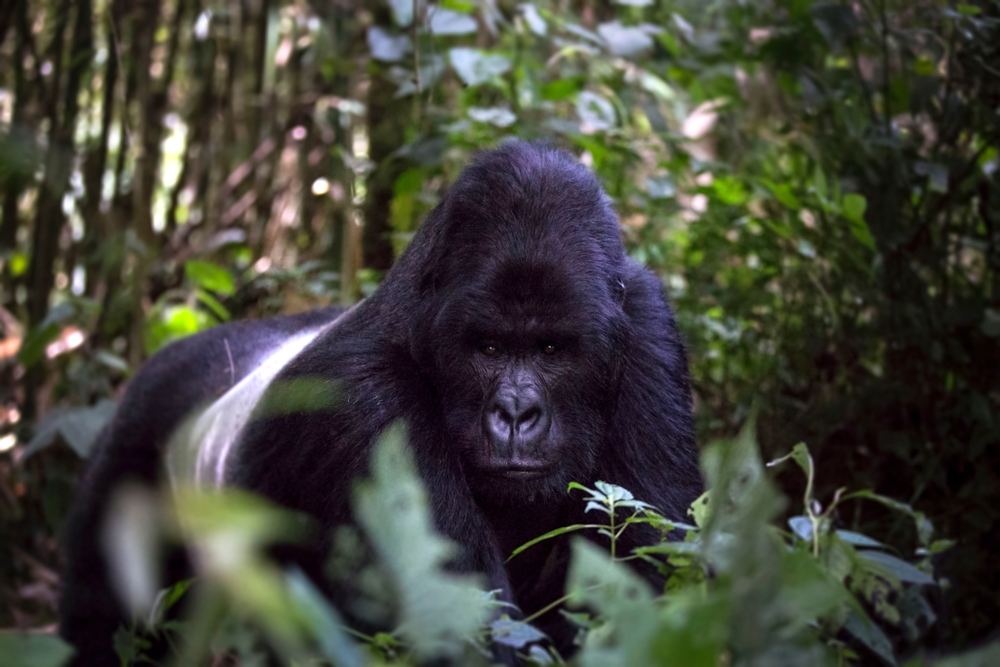
After a short introduction, we made our way through a thick green wall of plants and vines as the canopy rang with birdsong. After about two hours, the guide freezes like a statue. My heart started pounding – a sudden stop is always a good sign.
“Can you smell it?” he says.
I stick my nose up in the air… an unpleasant smell invades my nostrils. I couldn’t see them, but I’m pretty sure they could see us…
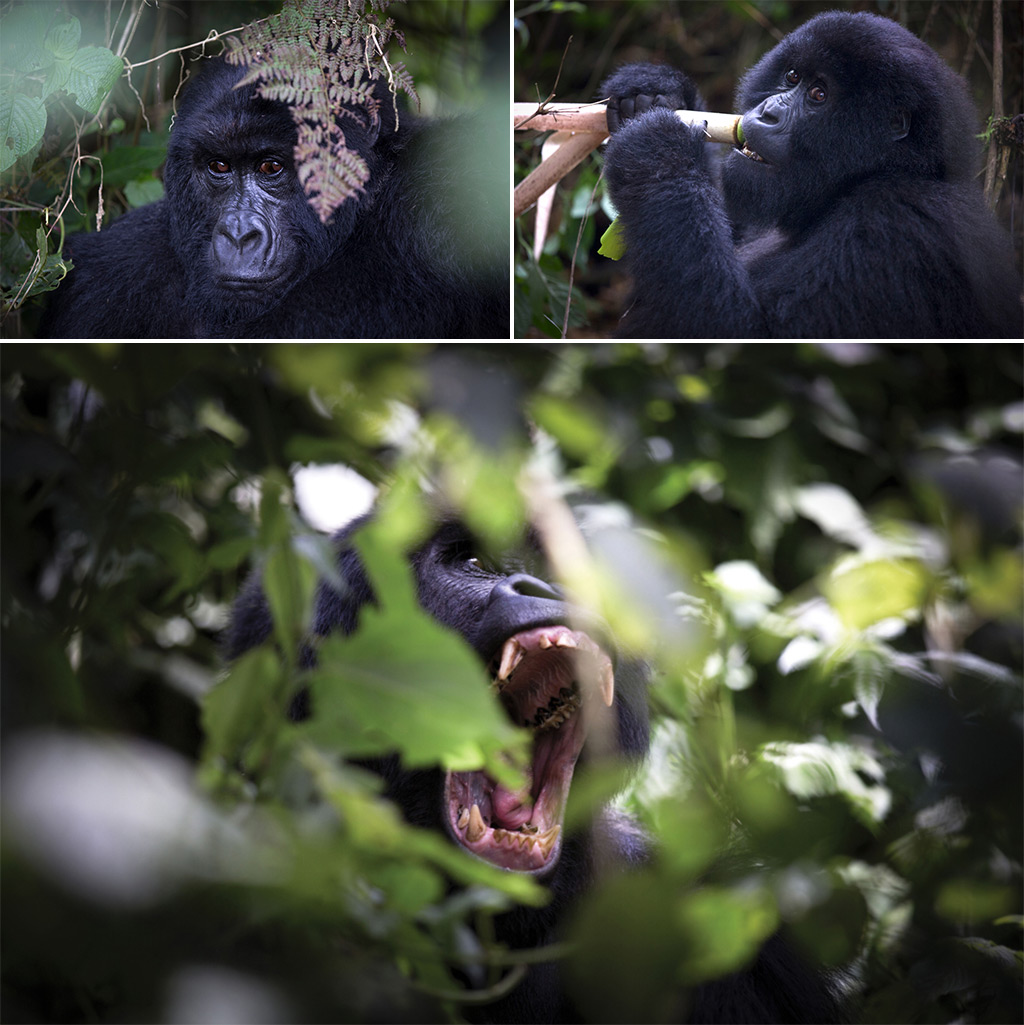
The first thing I saw were two amber eyes belonging to a female gorilla looking back at me curiously. I had disturbed her right in the middle of breakfast, typical me. My body froze, not from fear, but pure joy. Shortly after, she went back to her vegetarian buffet and continued eating like I wasn’t even there.
Instinctively I sat down near her in the lush bed of grass; somehow, it just felt more appropriate. When you visit a church, you bow, and at a concert, you stand. When you visit a gorilla, you should assume the posture of your distant ancestors.
It felt completely unreal. Even though she was just a few metres away, I couldn’t believe that what I was experiencing was real. I studied the distinct wrinkles in her face and those warm, intelligent eyes; I followed her five-fingered hands gently breaking off the bamboo; and admired her soft, black fur that shone in the sunbeams breaking through the foliage.
For a weird moment, I thought this couldn’t be real. These are men in gorilla suits: their hands are too shiny and plump – they look like bad imitations, like extras dressed as outer-space apes in an old episode of Star Trek. But they must be real because a human actor couldn’t imitate those feet.
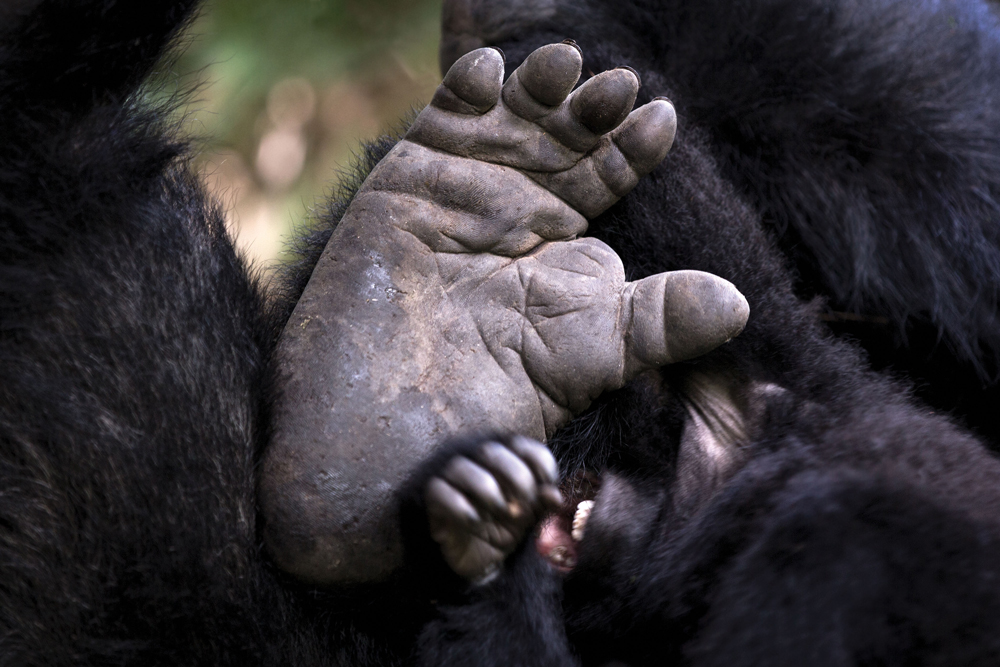
Then there are the noises: grunts, pants, yodels and sighs. There’s the cracking of roots and twigs, the crunching of fibrous bulbs. Maybe they don’t write poetry or read Dostojevskij, but gorillas have their language.
Suddenly, a young male makes his mark with a loud shout that echoes through the jungle. Did he say, “Good morning”, or “Where’s my breakfast?”.
Only one thing is for sure, a visit to the dentist wouldn’t hurt!
We then spotted a big silverback relaxing in the sun. Just the sheer size of his shoulders and biceps makes a heavyweight boxing champion look anorexic. And me? Compared to this mountain of muscles, I felt like one of those fire ants crawling around on the ground. You could immediately sense who the boss was.

After finishing his meal, the silverback suddenly started to walk straight towards me. I heard the guide’s instructions echo in my head:
“Stay at least 22 feet away and avoid sustained eye contact or finger-pointing. If a gorilla moves toward you, step calmly out of the way. If one charges, follow the guide’s instruction to drop to the ground in submission. And whatever you do, don’t freak out – the gorilla can sense your fear.”
Unfortunately, none of the advice seemed to help. It’s easy to brag or play macho, but when you have a 250 kg silverback passing by – so close you could feel his breath – you turn into a little pimple-faced altar boy.
“In more than 30 years, the guides have never had to shoot a gorilla, and no visitor has ever been harmed in an incident involving one”, the guide explains. “I mean, no incident apart from friendly kicks or slaps,” he added.
I’m pretty sure he says that to help me relax, but for some reason, the words don’t have any effect.
Later, we found the ‘boss’ in a shaded alcove not far from the first group. He was sitting upright with his legs crossed and his great furry mitts draped over his knees – his size, and the sweeping crown of his head distinguished him from the others. Surveying his domain, first left and then right, he could not look more imperial. As two youngsters tussled at his feet, he nudged one away so he could groom the other with his long, nimble fingers.
A little further on, we bumped into a whole group of gorillas who were relaxing in the early morning sun. Some were eating, and some were having a nap or picking fleas. A baby climbed onto his mother and went tumbling as she rolled over onto her side. He staggered to his feet, saw me and started tottering curiously towards me. I held my breath, but the guide hissed and gestured, and I had to back away, not because his parents would mind the contact, but because of our germs. Gorillas can catch the flu from us, and the common cold. We can kill them with our breath. Even in the moments of our greatest vulnerability, the threat is always from us to them.

Throughout our hour with these great apes, the enduring wonder was how close we were able to get. Our telephoto lenses poked through branches to find a new mother suckling her infant; a juvenile twirled its way down a bamboo stalk and scampered past my pant leg, near enough to high-five; a large female, perched just above us in low-hanging branches, methodically stripped bamboo stems as if she were shucking corn.
The longer we spent with them, the more I realised they were not the hairy monsters as portrayed in horror movies. In fact, unlike humans, there’s nothing aggressive about them at all. For millions of years, these gorillas have lived in balance with nature. Never over-populating, never destroying the nature that nurtures them. Maybe we should learn from them.
There are fewer than 900 mountain gorillas on the planet, and here I am surrounded by 12 of them. The privilege is overwhelming, but at the same time so very sad considering the poaching and destruction of habitat that they must endure.
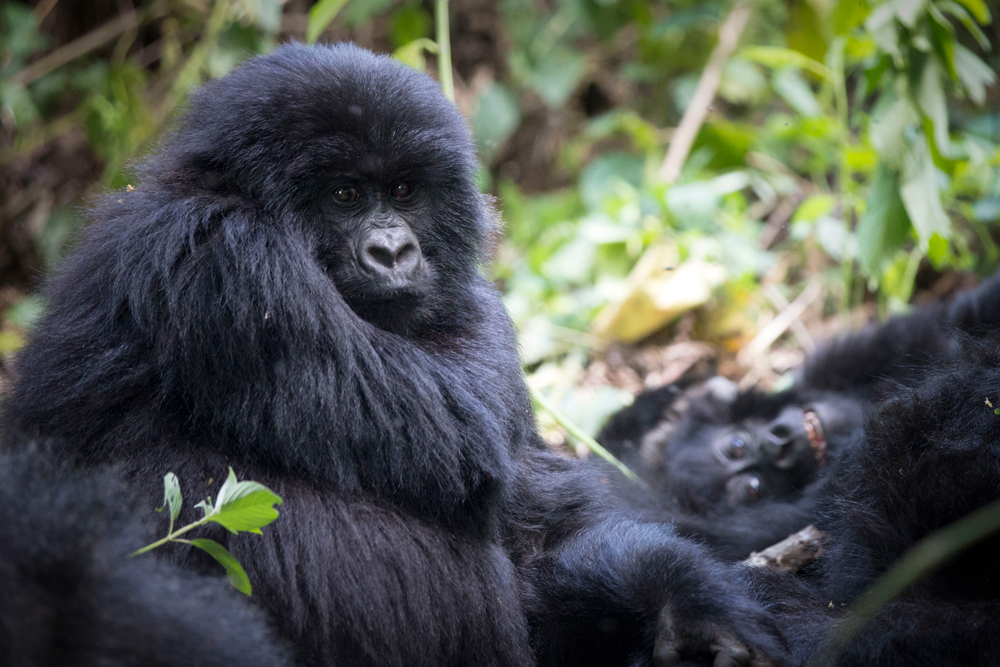
While I was with them, I became overwhelmed with the affection they showed to each other. Kids climbing on moms, siblings tussling, grown males reaching out and touching their brothers just to let them know they’re still there. Only the silverback stayed aloof, but even he came over and brushed against one of his children, or offered himself to be groomed. I wouldn’t call it love – we’re the only primates to evolve fancy-pants ideas like that – but through the touching, reassurance and comfort, you can see from where love grew.
I lived in the moment, watching these critically-endangered creatures experience what I like to believe all of the same emotions we feel each day: hunger, fatigue, boredom, curiosity, love, happiness, wariness, tolerance, respect, trust.
When the time was up, I felt incredibly disappointed, like a kid being forced to stop playing with his friends because it was time for dinner. I didn’t want to leave this place. I wanted to stay with the gorillas and get to know them. In just that short time with them, it felt like I was able to discover their personalities. Adrenaline was pumping through my body, and with a mixed feeling of joy and sadness, I finally forced myself to leave. This was the fastest (and most memorable) hour of my life.
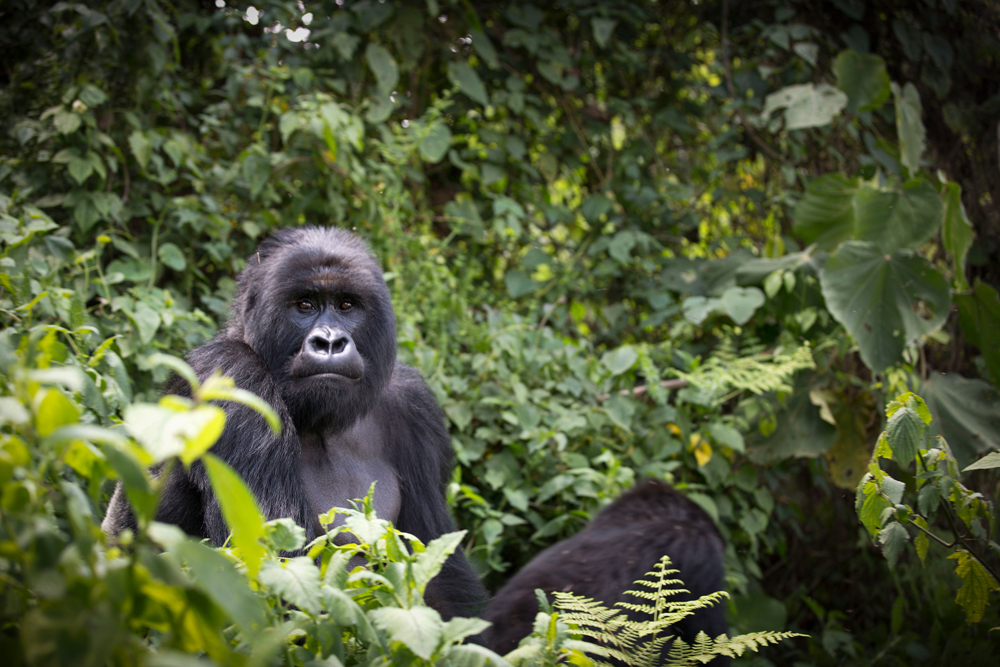
The golden monkeys of Volcanoes National Park
Just when I thought I couldn’t have had a more thrilling experience, it was time for another unique primate encounter. After a few hours on bumpy, practically nonexistent Congolese roads, we entered the beautiful Volcanoes National Park in Rwanda. Now it was time for the golden monkeys and another tick off my bucket list. Golden monkeys are approximately 50 centimetres tall, weigh around 7kg and look like some little creatures from a Star Wars movie.
They are an endangered species, and unique to the Virunga mountain range. Rwanda and Uganda are the only two countries where visitors have the opportunity of trekking to see them up close. I hope the incredible luck that I had with the gorillas would stay with me on this trek.
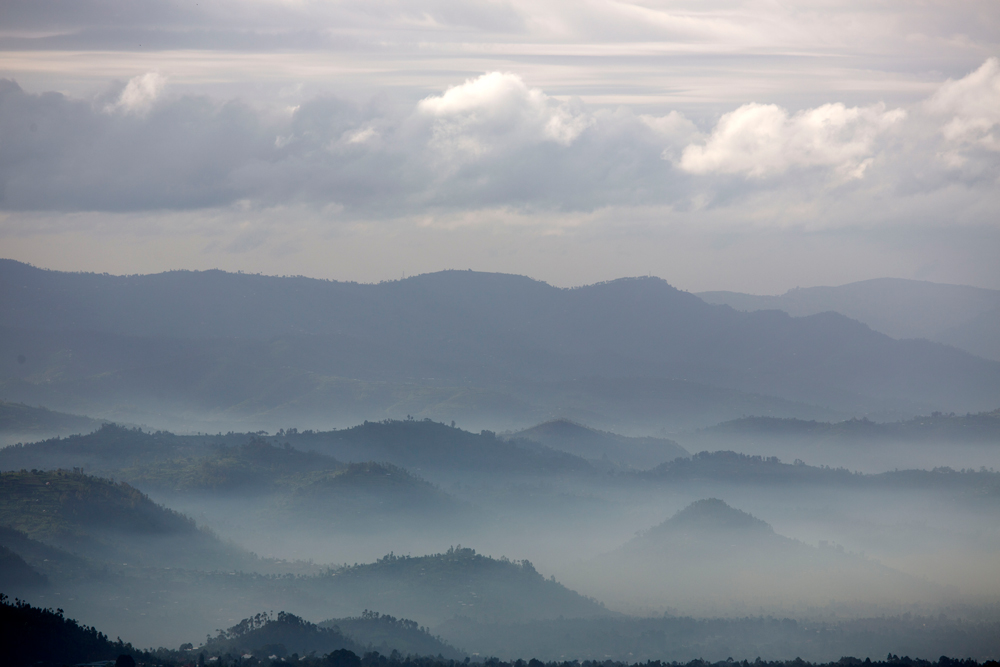
Trekking for these primates is not as hard when compared to their cousins, the gorillas. The only similarity is the landscape. Though the bamboo forest that we trekked through seemed never-ending, and I found myself wondering how we were ever going to find them in this eternal world of green.
After a 20-minute walk, our trackers told us the monkeys were close. We left our bags and looked up into the trees – within minutes we saw furry faces and inquisitive eyes peeking out from behind the thin bamboo stalks. I don’t think I had ever seen cuter animals in my life!
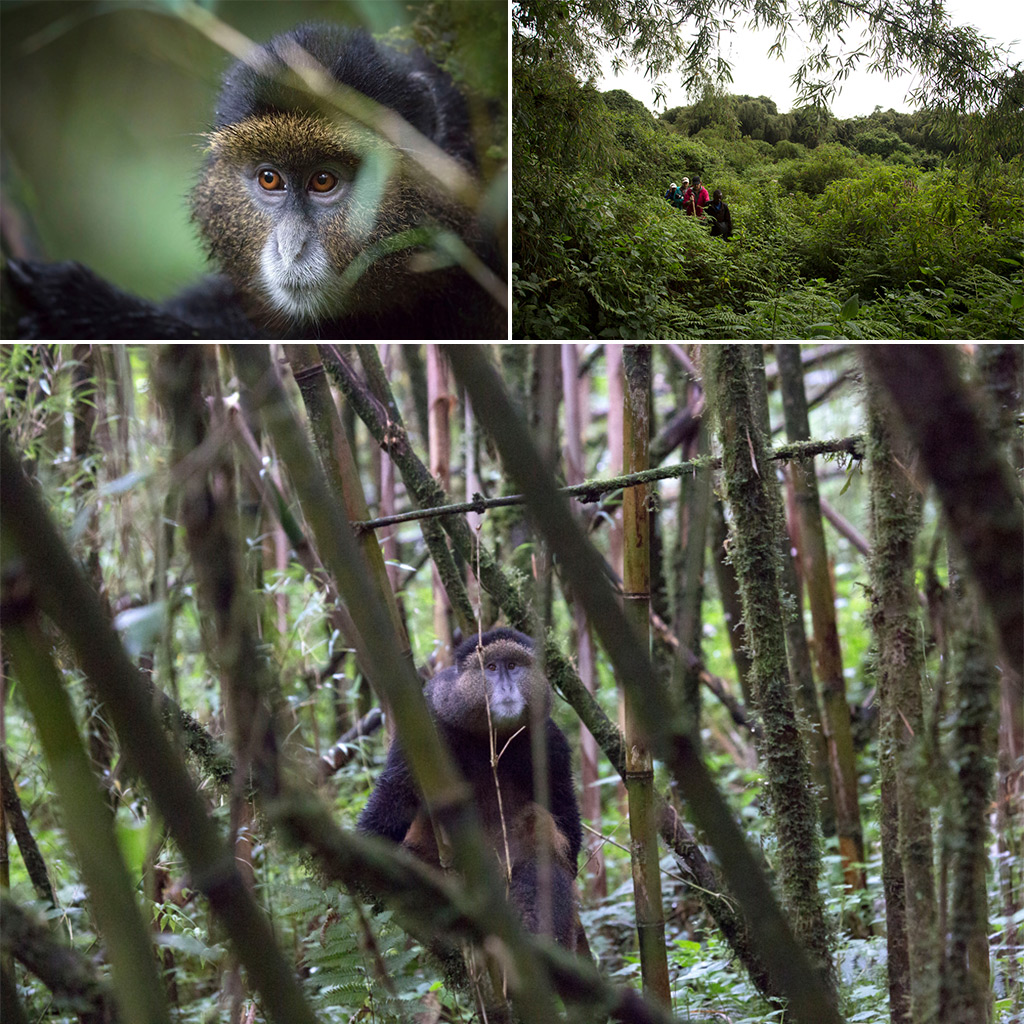
I discovered that these are some of the least shy monkeys around, as you can get as close as a metre to them. It turns out that these monkeys were real supermodels, taking every opportunity to get their faces in front of the camera lens!
The monkeys were playful and entrancing, their soft, reddish-gold fur creating a blur of colour as they darted and danced through the bamboo. They daintily jumped from one stalk to the next and sucked the sweet juice from bamboo shoots that they dug up from the forest floor.
The other people in the group had the time of their lives filling their memory cards full of images of these little teddy bear-like monkeys. The only problem was that many times the little guys got so close you couldn’t even get them in focus!
At one point, one of the little fellas got so close that he stepped on my arm. They might not be very impressive in size, but in the jungle that doesn’t seem to matter. Here, it is all about attitude.
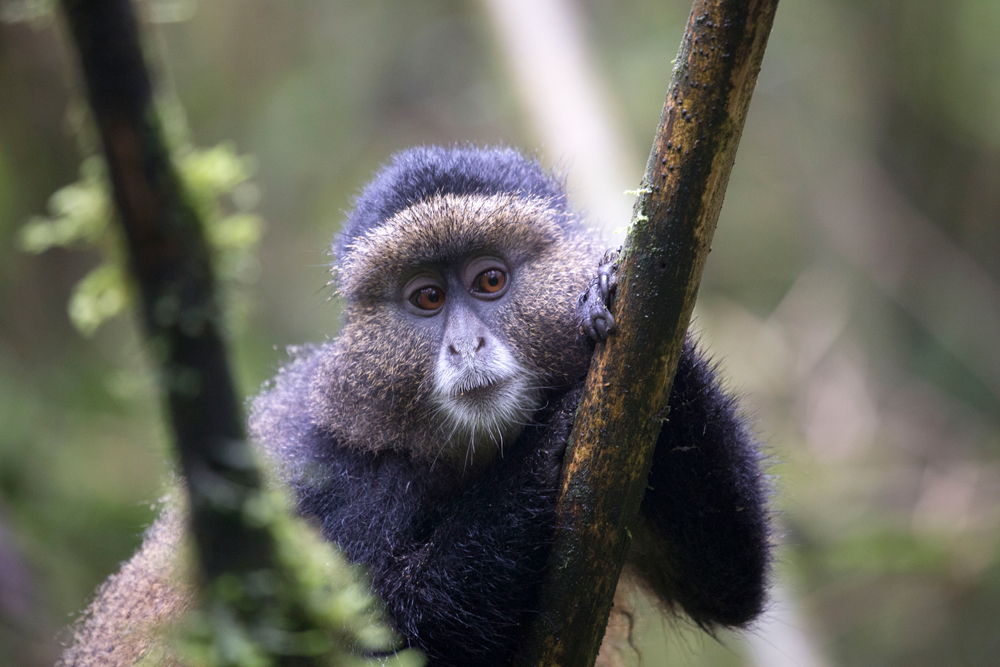
The rest of the hour passed by remarkably fast, but even so, the character of each monkey came out as we watched on – the mischievous adolescents making daring leaps between the vines; the bored-looking uncle who watches the younger ones playing; the timid curiosity of a two-month-old baby leaving the warmth of his mother. It was easy to see this troop as a family, connected in a myriad of ways, just as the vines and leaves of the bamboo wove together to create a beautiful tapestry of life in the forest.
It was hard when I had to say goodbye to the gorillas; my heart broke once more when we said goodbye to the golden monkeys. The visit was way too short, but the memory of their incredibly cute faces and big, curious eyes will stay with me forever. ![]()
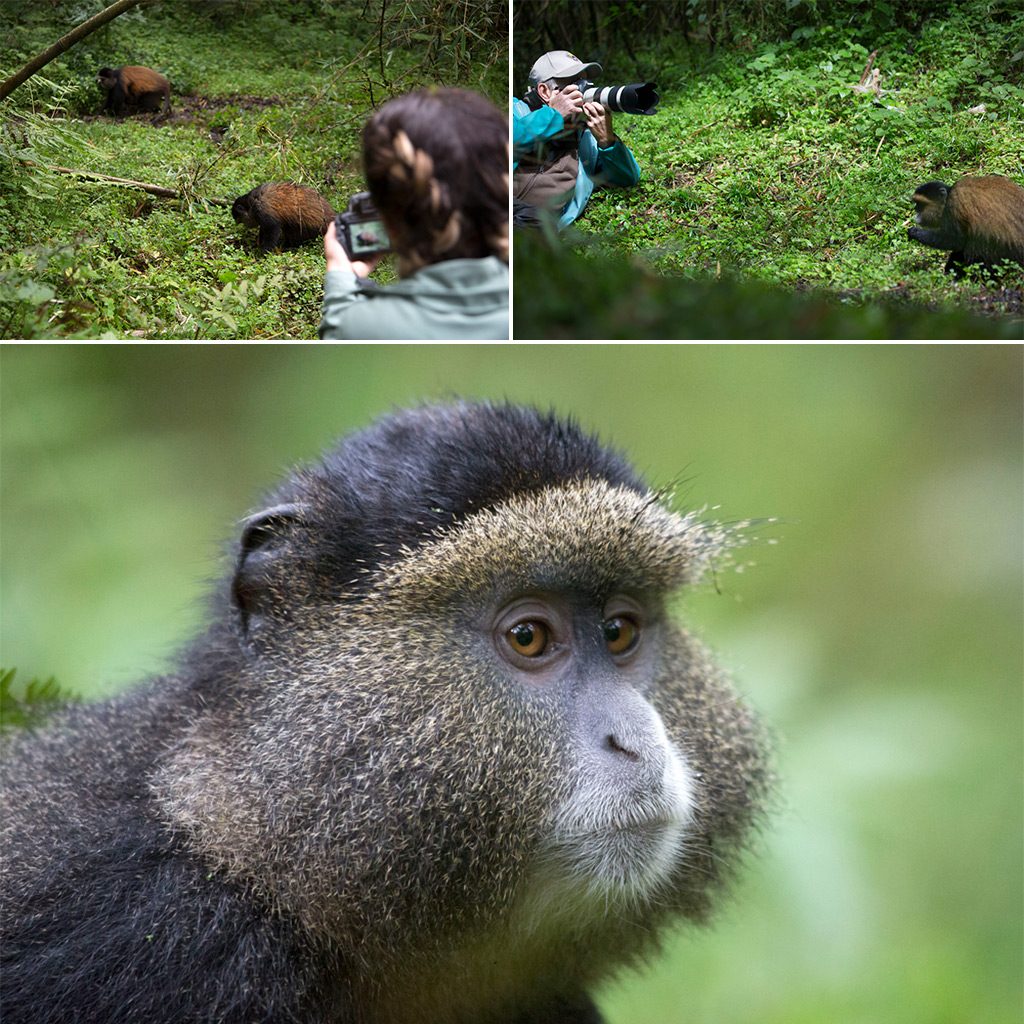
Click here to see some of our primate safaris:
• Ultimate primate safari
• Climbing Mount Nyiragongo and mountain gorilla trekking
• Lowland gorilla trekking
• 3-day mountain gorilla trekking in Uganda in Bwindi Impenetrable National Park
• Gorilla trekking in Rwanda in Volcanoes National Park

ABOUT THE AUTHOR
 Björn Persson is a photographer and travel writer who’s visited over 20 African countries. His favourite destination is Kenya, but the Nyiragongo hike – featured here – was one of his most memorable adventures. Besides being an avid traveller, Björn also has a degree in wildlife conservation and uses his photos as a weapon against poaching. His first wildlife photography book, The Real Owners of the Planet, is being released later this year. A big part of the profit will go to wildlife conservation.
Björn Persson is a photographer and travel writer who’s visited over 20 African countries. His favourite destination is Kenya, but the Nyiragongo hike – featured here – was one of his most memorable adventures. Besides being an avid traveller, Björn also has a degree in wildlife conservation and uses his photos as a weapon against poaching. His first wildlife photography book, The Real Owners of the Planet, is being released later this year. A big part of the profit will go to wildlife conservation.
To comment on this story: Login (or sign up) to our app here - it's a troll-free safe place 🙂.![]()






